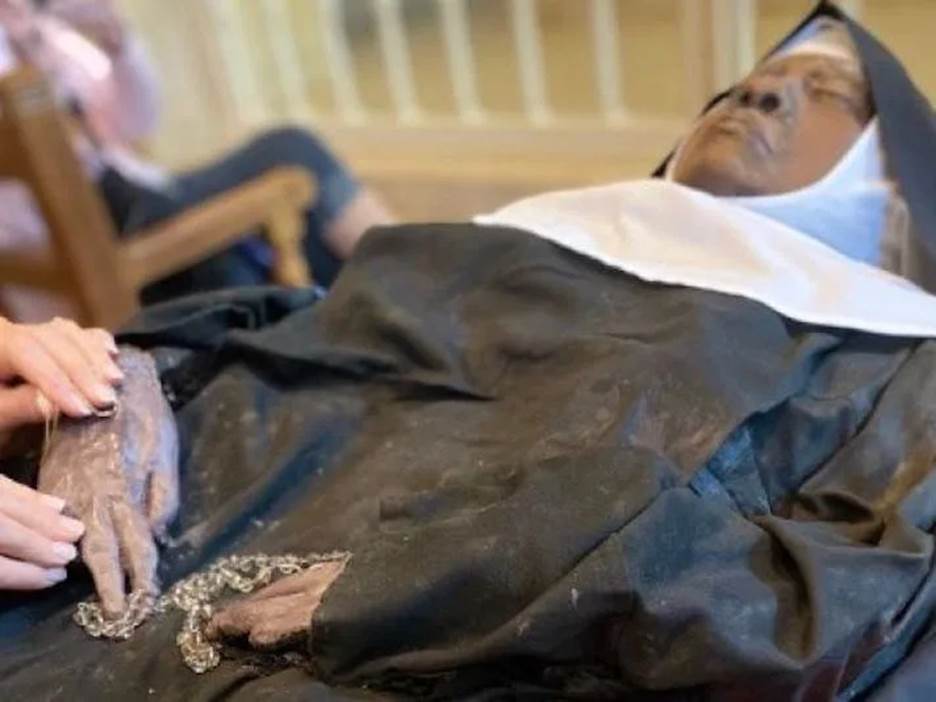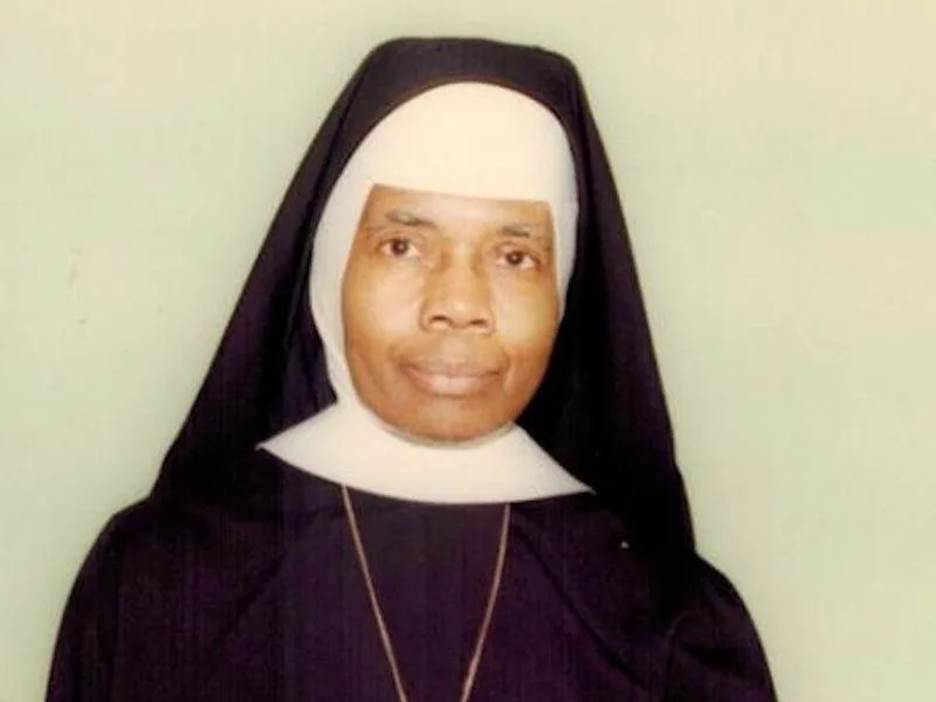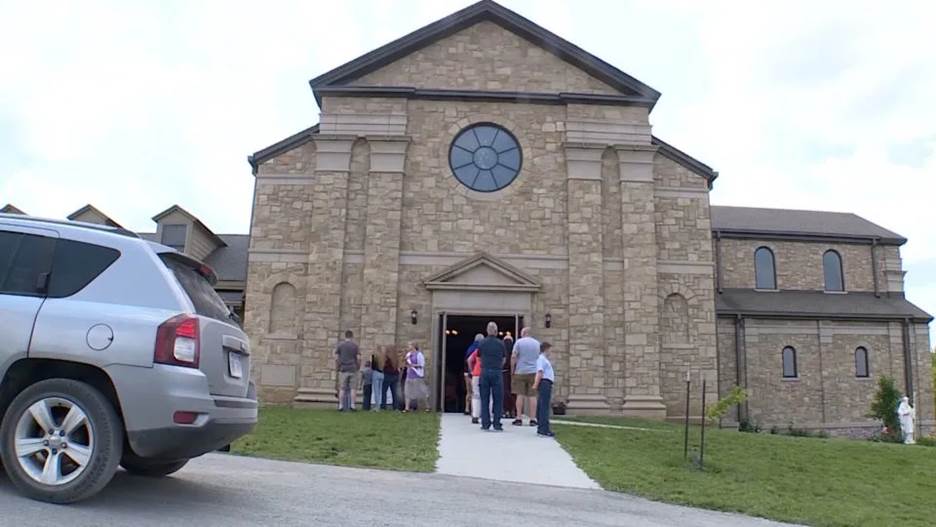
The body of Sister Wilhelmina Lancaster - Kelsey Wicks/Catholic News Agency
A Missouri Nun's Body Seems intact 4 Years after She Was Buried
By Natalie Musumeci
The recently exhumed body of a Missouri nun is attracting the influx of hundreds of pilgrims after the corpse was discovered remarkably intact after four years with no signs of decomposition.
Some have described the revelation of the preserved remains of Sister Wilhelmina Lancaster as a "miracle in Missouri."
Lancaster, the founder of the Benedictine Sisters of Mary, Queen of Apostles, died in 2019, aged 95. Her body was not embalmed and was buried in a wooden coffin in Gower, Missouri, the Catholic News Agency reported .
Last week — four years after Lancaster's death — the Benedictine Sisters decided to unearth Lancaster's body to move her remains under the altar in their convent's chapel as is customary for founders, according to the Catholic News Agency.
The sisters were reportedly stunned when they opened the coffin, which even had a crack down the middle.
"We were told by cemetery personnel to expect just bones in the conditions, as Sister Wilhelmina was buried without embalming and in a simple wood coffin," one nun, who was not identified, told Newsweek .
The sister told the news outlet that when Mother Abbess Cecilia peered through the crack in the coffin, "she saw a totally intact foot with the sock on, looking just like it did when we had buried her."
"She could not help but scream with joy," the sister said.

Sister Wilhelmina Lancaster - The Benedictines of Mary, Queen of Apostles
When the sisters realized Lancaster's body was still totally intact, they "took turns feeling the still-socked feet," the nun told Newsweek.
"The dirt that fell in early on had pushed down on her facial features, especially the right eye, so we did place a wax mask over it. But her eyelashes, hair, eyebrows, nose, and lips were all present, her mouth just about to smile," the sister said.
As the news spread on social media, droves of people began flocking to the Missouri town to visit the body, according to the Catholic News Agency.
Lancaster's body will be displayed in the sisters' chapel in Gower until May 29 and then will be encased in glass.
Typically, without preservation techniques like embalming or mummification, the human body slowly begins to decay the moment a person's heart stops beating, Insider previously reported .
In many cases, the body will decompose until all that's left are the bones. - Insider
CNN adds: … When the coffin was unearthed, Lancaster’s body was apparently “incorrupt,” which in Catholic tradition refers to the preservation of the body from normal decay. The remains were intact even though the body had not been embalmed and was in a wooden coffin, according to the news outlet.
The discovery has captured the attention of some members of the church, and prompted an investigation.
The Diocese of Kansas City-St Joseph issued a statement about the discovery.
“The condition of the remains of Sister Wilhelmina Lancaster has understandably generated widespread interest and raised important questions,” the diocese said. “At the same time, it is important to protect the integrity of the mortal remains of Sister Wilhelmina to allow for a thorough investigation… Bishop [James] Johnston invites all the Faithful to continue praying during this time of investigation for God’s will.”
The statement from the diocese notes “Incorruptibility” is very rare, and a “well-established process to pursue the cause for sainthood,” but the process has not begun in Lancaster’s case.

Benedictines of Mary, Queen of Apostles Monastery in Gower, Missouri - KMBC
The Catholic News Agency reports that more than 100 incorruptible bodies have been canonized – their bodies defying the decaying process. In Catholicism incorruptible saints give witness to the truth of the resurrection and life that is to come.
Experts say it is not necessarily uncommon for bodies to remain well-preserved, especially in the first few years after death.
Western Carolina University Associate Professor and Director of Forensic Anthropology Nicholas V. Passalacqua told CNN in an email, “It’s hard to say how common this is, because bodies are rarely exhumed after burial. But there are many famous cases of well-preserved human remains. Not just things like Egyptian mummies which were intentionally preserved, but also things like the Bog Bodies of Europe which were very well preserved for thousands of years because they were in environments with low oxygen that restricted bacterial grown and access of the remains to scavengers.”
Passalacqua also noted “in general, when we bury a body at our human decomposition facility, we expect it will take ~5 years for the body to become skeletonized. That is without a coffin or any other container or wrapping surrounding the remains. So for this body, which was buried in a coffin, I personally don’t find it too surprising that the remains are relatively well preserved after only four years.”
The body will be laid out in the sisters’ chapel until May 29, according to the Catholic News Agency, when the sisters plan a rosary procession. After the procession, Sister Wilhelmina’s body will be encased in glass near the altar of St Joseph in the chapel in order to welcome devotees.
CNN has reached out to the Benedictines of Mary, Queen of Apostles Monastery for more information.- CNN

